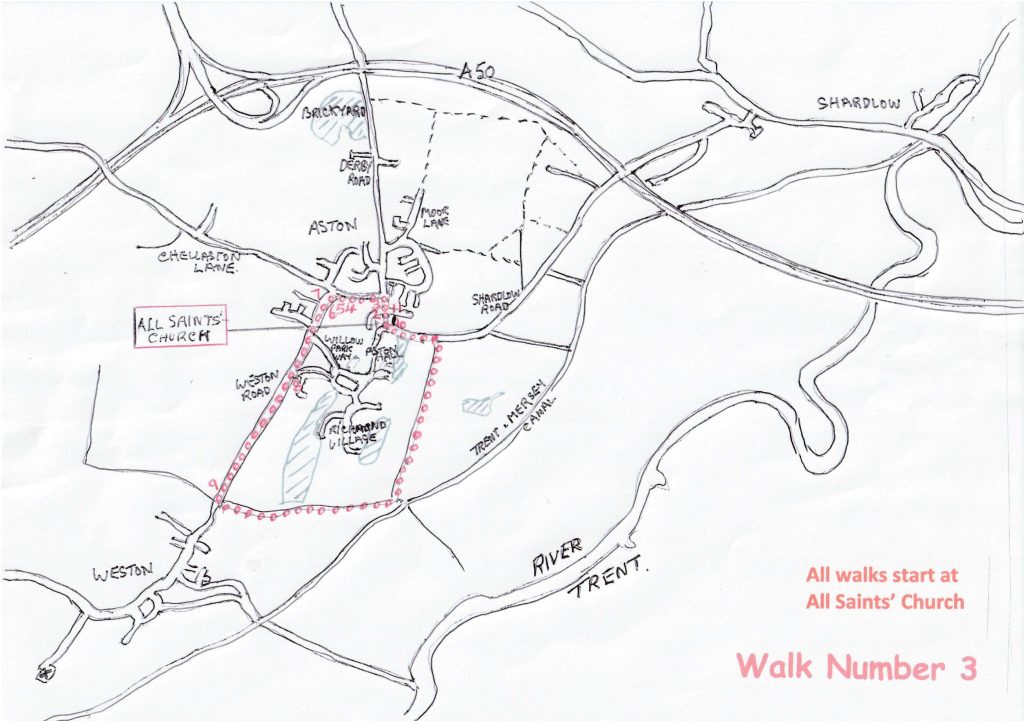One of a series of local walks produced by
Aston on Trent Local History Group
*More detailed route information and other footpath links can be found on OS Explorer Maps 245/259.
If you have mobility issues please check first

Aston on Trent History Walks
Number: 3
(The Short Weston Circuit)
2.4 miles / 4 kms
Approximate time – 1 – 1.25 hours
Flat easy walking. Most walks use countryside footpaths. Please consider weather and ground conditions.
This pack contains a basic map, route directions * and history notes

Aston on Trent History Walks
Number 3 (The Short Weston Circuit)
- From All Saints Church. Lychgate(1) walk north towards the village Post Office passing Rectory Gardens (2) and Rectory Mews (3)
- Turn left along Weston Road past the village shop, Ledmore Cottage (4).
Posey Lane(5) and Hilton Gardens(6)
- Stay on Weston Road, following the bend. On the opposite corner lies the village War Memorial Hall (7)
- As you leave the village you pass Willow Park Way on your left, then Red Lodge(8).
- After ¾ mile you enter Weston village (9)
- Passing ‘Grange Lynn’ house take the track on your left between houses and into open fields beyond the metal barrier.
- In front, about 500 yds you will pass Long Walk Wood on your left.
- Keep to the track between open fields and hedgerow until the track joins a gravel driveway with Weston Grange farm in front of you. To your right is the bridge over the Trent & Mersey canal.
- Take the gravel driveway to your left passing a narrow tree line to your left and a large field to your right with Bird Cage Copse at its centre.
- The driveway takes you to Shardlow Road passing stables.
- Turn left following the road, past the White House (10) back to All Saints’ Church.
- Opposite the church is Lodge Estate(11), site of the former Aston Lodge
We hope you enjoyed your walk.
Find more at www.astonontrenthistory.co.uk
Items of Historic Interest – Walk Number 3
1.Lychgate Built in 1919 as a memorial to the Rev. James Shuttleworth Holden who died in 1916. He was the Rector of Aston for 47 years.
2. Rectory Gardens A small development of modern dwellings built in the early 1970s following the demolition of the former Georgian/Victorian Rectory in 1969.
3. Rectory Mews The first building on the corner of Weston road once contained late 18th century stables, coach house and groom’s quarters for the Rectory. Of similar date are the cottages on the right of the road with their third floor probably contained cottage industries such as framework knitting. The Village Shop and the cottages on its driveway were, before 1924, part of the Aston Hall Estate and contained a house, office and estate yard as part of the Home Farm.
4. Ledmore Cottage Wells Buses ran a regular service between Weston, Aston and Derby being garaged and maintained in the yard at the rear of this cottage and were taken over by Trent Motor Traction during the Second World War. Legend has it that drivers would, by special request, bring fish and chips back from Derby on Fridays.
5. Posey Lane The origin of its name is not known. On the right of this lane survives an example of a water pump used for domestic purposes before Aston received mains water during the 1920s.
6. Hilton Gardens A modern housing development named to honour Harold Hilton who died in 1998. He was the headmaster at Aston’s village school for twenty-two years between 1961 and 1983.
7. War Memorial Hall lies at the junction of Weston Road and Chellaston Lane; Aston’s tribute to the 19 men who fell in WW1 and one man from WW2. The Hall was built on land donated by William Dickson Winterbottom of Aston Hall and formally opened on the 11th February 1922 by his wife.
8. Red Lodge A building of distinctive design which served as the western entrance lodge to the Aston Hall Estate.
9. Weston on Trent In the year 1009 King Ethelred the Unready granted a charter recognising the boundaries of Weston (the West Settlement). This estate included the hamlets of Aston (the East Settlement), Shardlow, Wilne and parts of Morley, Smalley, Ingleby and Crich.
10. The White House At the church corner of Shardlow Road, this was formerly a lodge and head butler’s residence serving Aston Hall. The arches in the brickwork of the wall were once open to allow village residents to access water from troughs, being piped from a spring located on the west side of the Hall. This facility was provided to improve privacy for the Hall residents.
11. Lodge Estate and Park View was developed in 1933 after the demolition of Aston Lodge, a major house built around the same time as Aston Hall (1735). Part of Aston Lodge land was used for the establishment of NOTSA Engineering which produced precision components and measuring equipment for major engineering companies. The company was bought by Ferranti who closed the works in 1984. NOTSA is Aston spelt in reverse!